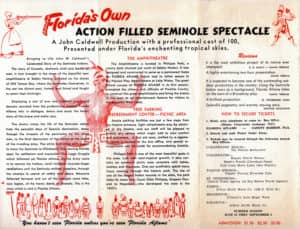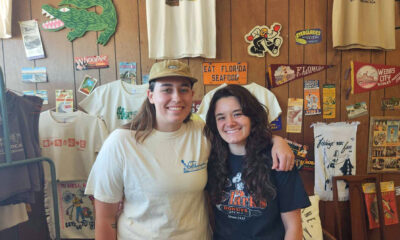Vintage Pinellas: Seminoles in Safety Harbor, nightly (except Monday)
Just as Professor Harold Hill rode into River City, Iowa and hoodwinked the locals into bankrolling his nonexistent “boys’ band,” so Pinellas County fell under the spell of snake-oil salesmen in the 1950s, promising a financial windfall if an outdoor amphitheater was constructed in leafy Philippe Park.
When the dust settled, Budget Board Chairman Thomas L. Smith declared the $65,000 project “the biggest bill of goods ever sold in the county.”
This wasn’t the fictitious small town of the Broadway hit The Music Man – although snappy tunes, colorful costumes and civic pride were involved.
Taxpayers’ money had been used, via a bond issue, to build a 1,700-seat amphitheater near the rural park’s ancient Tocobaga Indian mound expressly for Florida Aflame, a two-hour, 24-scene historical play about the brutal displacement of the Seminole Indians by the American army in the 19th century.
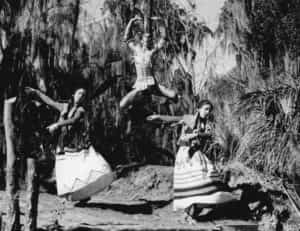
A scene from “Florida Aflame” in Philippe Park, 1955. ZUMA Wire/Tampa Bay Times.
Outdoor historical dramas were big business at the time – Unto These Hills was packing them in in Cherokee, North Carolina. Not far away in the city of Boone, there was Horn of the West, and Roanoke, Virginia was home to The Lost Colony.
South Dakota’s Black Hills Passion Play, a narrative about the last days of Jesus Christ, began wintering in Lake Wales in 1951, in an outdoor theater financed by Polk County government. There, it would remain for an astonishing 45 seasons.
That’s not what happened with Florida Aflame.
Winter Haven native John Caldwell wrote Florida Aflame as his University of North Carolina master’s thesis; produced by an organization called the Florida Seminole Association, the staged play had been presented the previous summer in the Lake Wales amphitheater, while the religious pageant was away in the Black Hills. It was not a success.
Caldwell and his producers (a group that included Clearwater businessman Daryl Swan) then approached Pinellas County about using 72-acre Philippe Park, on the shore of North Tampa Bay in the town of Safety Harbor, as a permanent home for their show. Promises were made about the vast amounts of winter-season tourist dollars that would be generated; Florida Aflame, locals were assured, would help to put the Central West Coast of Florida on the radar of all entertainment-seeking Americans.
The St. Petersburg Times endorsed the sale of public bonds ($50 per, paying five percent annually), assuring readers that Florida Aflame was a sure thing. “I feel that we have hardly begun to realize the amusement and general pleasure potential locked up in this very beautiful nook of Pinellas County,” said Safety Harbor mayor Con Barth.
The county signed a 10-year contract with Florida Aflame.
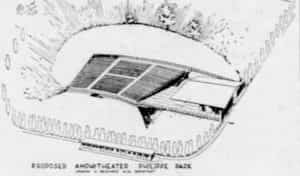
Architect Joseph Messineo’s original amphitheater design.
The Tocobaga lived on this land more than 1,000 years ago, and the historic mound – an enormous, grass-covered repository of shells, animal bones, bits of pottery and other remnants of their civilization – is prized by archaeologists and historians. In the 1960s, it was added to the National Register of Historic Places.
Philippe Park was named for Odet Philippe, a French nobleman who settled in what became upper Pinellas in 1842. Credited for introducing cigar-making and citrus to the area (he was, it’s believed, the first in the state to cultivate grapefruit), Philippe established a working plantation, St. Helena, along the upper bay. He was also a slaveholder.
He died there in 1869 and is buried on the property; the exact location of his gravesite is unknown.
Pinellas County acquired the land in 1948 and opened Philippe Park, on less than a quarter of Odet Philippe’s 160 acres, in 1952. Additional acreage was added to the county park over the years (today, it includes 122 acres).
History came alive – in a manner of speaking – with the outdoor production of Count Philippe’s Wild Orange Tree, written and directed by local historians Sydney and Marjorie Greenbie for the ’52 opening ceremonies.
Presented on a makeshift wooden stage at the base of the Tocobago mound, the three-hour play – narrated by Sydney Greenbie – combined documented fact and epic scenes of tall-tale fiction.
This show ran for several weeks, in all weathers, with the audience seated on folding chairs.
The Times reviewer was not kind: “Lady Hortense, played by Doris Dureya of St. Petersburg, although overacting her part as the petulant, spoiled wife of Philippe, stuck to her lines better than the majority of the players.”
And this: “The Rev. John Maddox as Parson Brown added a note of sobriety to a show otherwise rampant with pirates, Indians and ballet dancers.”
That March, 200 people attended the Chascos Fiesta Calusas Indian Pageant, by a New Port Richey thespian group – and midway through 1953, the producers of Florida Aflame came sniffing around.
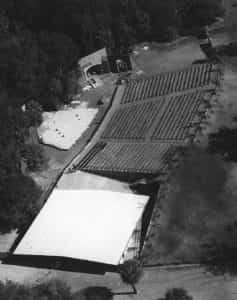
The Philippe Park amphitheater. Photo from the collection of Thomas Pluckhahn.
Groundbreaking for the amphitheater’s 160-foot stage and raised wooden grandstands, designed by architect Joseph Messineo, took place on Aug. 14, 1954. At the ceremony, St. Petersburg mayor Samuel G. Johnson declared that Florida Aflame would be the major attraction of the 1954-55 season, second only to the opening of the Sunshine Skyway Bridge in September.
Also present were the mayors of Tarpon Springs, Clearwater, Dunedin, Safety Harbor, Oldsmar, Belle Vista and Belleaire, and representatives from the chambers of commerce.
Hands were rubbed in anticipation of the droves that would attend the “concerts, athletic events and other attractions” that would inevitably be scheduled between Florida Aflame seasons, and the corresponding money destined for local coffers.
“We expect Indians to pop out of Philippe Park any day now,” the construction foreman gleefully told a reporter.
They popped out at 9 p.m. on Saturday, Jan. 22, 1955, opening day. The audience sat in aluminum lawn chairs with webbed backs, bolted to the grandstands, to watch the premier performance of Florida Aflame. The crowd included 30 specially-invited members of the Seminole Indian nation.
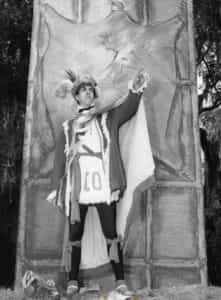
Osceola (Kelton Garwood) announces the start of the “Green Corn Dance.” Zuma Wire/Tampa Bay Times.
The pageant began with whoops and hollers from behind the towering oaks and pines, followed by the booming, disembodied voice of Seminole leader Osceola (actor Kelton Garwood): “This is my story. These are my people. This is my land.” The elaborate drama unfolded on three connected stages, illuminated by lights from a below-ground pit.
Professional dancer Peter De Maio then performed the first in a series of (adapted) ceremonial dances.
 The 88-member, mostly-white cast appeared as villagers, Americans, Spaniards, soldiers and Seminole chieftains and warriors with names (some of them real) like Alligator, Wild Cat, Jumper, Micanopy and Emathla. Although dramatic license was taken, the plot more or less adhered to the sad, bloody truth of the Seminole wars, and Osceola’s betrayal by the United States military.
The 88-member, mostly-white cast appeared as villagers, Americans, Spaniards, soldiers and Seminole chieftains and warriors with names (some of them real) like Alligator, Wild Cat, Jumper, Micanopy and Emathla. Although dramatic license was taken, the plot more or less adhered to the sad, bloody truth of the Seminole wars, and Osceola’s betrayal by the United States military.
Bounded by a pulse-quickening prologue and a superbly dramatized epilogue, Florida Aflame at Philippe Park Amphitheatre is an enchanted world … Here, the tragic history of the Seminole Indians unfolds in a two-hour production packed with action, color, fascinating music, beautiful dances and moments of tenderness and humor. It adds up to wonderful theatre.
Peri Tucker, St. Petersburg Times/Jan. 23, 1955
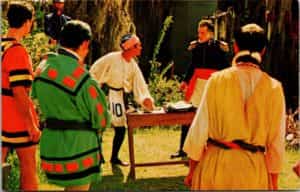
Unfortunately, it was all downhill from there, as a bitter cold front moved in and kept audiences away. Rain and bugs didn’t help. The show carried a steep overhead (weekly payroll was $4,000), and playing it for 100 people (or fewer) six nights per week meant the bills began piling up fast.
In a Feb. 7 letter to the county, Swan, the Florida Seminole Association president, said that paid admissions for the first 11 performances totaled 1,023. “We need 2,500 paid admissions per week to break even.”
To adjust, the group began offering matinees. By March, members of the company were asked to accept pay cuts. As some left, others stepped in to play two, sometimes three, roles.
When the show finally limped to the finish line on April 17, the optimism of late 1954 had vanished. “If Florida Aflame cannot open again, we will still have our contract with the county but no revenue,” Swan declared ominously. “That means no money back for the bondholders.”
In June, the Florida Seminole Association told county commissioners that it was $148,000 in debt and couldn’t pay its bills; Florida Power cut off electricity to the Phillipe Park amphitheater. The bankrupt production was sued for non-payment by the manufacturer of the aluminum chairs.
“After this winter’s disastrous season, April, Florida Aflame flamed out in mid-April, leaving a host of unpaid bills and IOU’s by many members of the cast,” announced Smith, the Budget Board chairman.
“In addition to bilking the county, they also took the City of Clearwater for another $10,000, leaving two handsome stock certificates as mementoes.”
Negotiations began in earnest to bring some sort of life back to the outdoor venue; for a time, the financially-troubled St. Petersburg Operetta considered the park for its productions.
Ultimately the American Savoyards, a professional New York company specializing in the comic operas of Gilbert and Sullivan, was the only taker. The Savoyards began a season in March, 1956, the county having given them a sweetheart deal ($1 for a 10-week rental of the facilities), with The Mikado.
The first complaints came just three weeks into the run, as Savoyard officials blamed record cold, and the apparent disinterest of locals, for the company’s poor box office showing.
On May 6, they closed the season with Ruddigore, two weeks earlier than announced. “We want to come back to Pinellas County next year,” said the group’s director, “in an indoor theater either in St. Petersburg or Clearwater. To justify our return, we need sufficient expression of intention to buy season tickets for next year.”
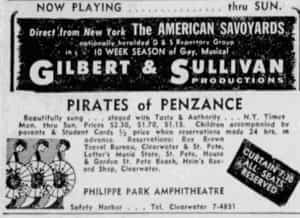
Pinellas County in 1957 seized all Florida Aflame assets “abandoned” at the amphitheater; Parks supervisor A.O. Smith detailed what was discovered in the dressing rooms and backstage shop: Dozens of Indian costumes, leotards and loincloths, a flintlock, ceremonial plume poles, swords and blankets, lighting equipment and furniture. “They makeup they left deteriorated, and we threw it out,” he told a Times reporter.
The county sold the spotlights for a cool $400.
“I sort of hope that some civic group might use the costumes to benefit a good cause,” Smith said. “Maybe the boy scouts could put on a play about Indians. Something will come along.”
Nothing ever did, and the amphitheater was left to the elements, wild vegetation re-claiming the stage area, the wooden grandstands rotting under the hot Florida sun. Playwright John Caldwell joined the theater faculty at the University of South Florida, but he resigned in 1962 after a controversial legislative probe instigated by State Senator Charley E. Johns.
That same year, Pinellas County bulldozers took out the remains of the Florida Aflame amphitheater, and covered the scars – and the bad memories – with sod.
